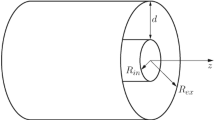Abstract
Bhatnagar and Rathna (Quar. Journ. Mech. Appl. Maths., 1963,16, 329) investigated the flows of Newtonian, Reiner-Rivlin and Rivlin-Ericksen fluids between two rotating coaxial cones. In case of the last two types of fluids, they predicted the breaking of secondary flow field in any meridian plane. We find that such breaking is avoided by the application of a sufficiently strong azimuthal magnetic field arising from a line current along the axis of the cones.
Similar content being viewed by others
Abbreviations
- B :
-
magnetic induction vector
- E :
-
electric intensity
- H :
-
magnetic field
- D :
-
displacement vector
- J :
-
current density vector
- ρ e :
-
excess charge density
- σ :
-
electrical conductivity
- ε :
-
dielectric constant
- j :
-
axial current
- V :
-
velocity vector
- T :
-
stress tensor
- e :
-
rate of strain tensor
- D :
-
acceleration gradient tensor
- I :
-
idem tensor
- P :
-
pressure
- ρ :
-
density
- η :
-
coefficient of viscosity
- η c :
-
coefficient of cross-viscosity
- η v :
-
coefficient of viscoelasticity
- Ω :
-
characteristic angular velocity
Reference
Bhatnagar, P. L. and Rathna, S. L.Quar. Journ. Mech. Appl. Maths., 1963,16, 329. S. L.
Author information
Authors and Affiliations
Rights and permissions
About this article
Cite this article
Mohan Rao, D.K., Bhatnagar, P.L. Flow of an electrically conducting non-newtonian fluid between two rotating coaxial cones in the presence of external magnetic field due to an axial current. Proc. Indian Acad. Sci. 59, 269–284 (1964). https://doi.org/10.1007/BF03046441
Received:
Issue Date:
DOI: https://doi.org/10.1007/BF03046441




